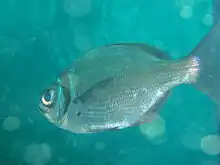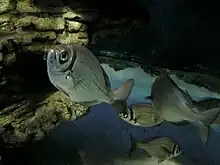Boopsoidea inornata
Boopsoidea inornata, the Fransmadam or Karel grootoog, is a species of marine fish in the seabream family (family Sparidae) of order Perciformes. It is native to the south coast of South Africa.
| Boopsoidea inornata | |
|---|---|
 | |
| Scientific classification | |
| Kingdom: | |
| Phylum: | |
| Class: | |
| Order: | |
| Family: | |
| Genus: | Castelnau, 1861 |
| Species: | B. inornata |
| Binomial name | |
| Boopsoidea inornata Castelnau, 1861 | |
Distribution
Swartvlei (Cape Town) to Aliwal Shoal, endemic.[1]
Description

A deep bodied fish with a pointed head and large eye. Adult body colour is bronze to silver with a distinctive dark edge to the gill covers. Small juveniles are a reddish orange, fading with growth to silvery with orange to yellow fins. Length is up to 30 cm, and weight seldom exceeds 0.4 kg.[2][3]
Habitat
Usually on rocky reefs in depths of about 5 to 35 m.[3] B. inornata is omnivorous, and prefers small sand- and reef-dwelling prey. Intake of algae and small fish is relatively small.[5] Adults feed on tunicates, polychaete worms, crustaceans (amphipods, decapods, isopods and mysids), molluscs, bryozoans, plankton and seaweeds for their animal encrustations.[2][1][6] Its preferred temperature range is 17.6 - 27.5°C.[7]
Life cycle
Boopsoidea inornata is a rudimentary hermaphrodite. It is a long lived, polygamous, resident species. Females spawn throughout the year, but mostly in spring.[5] The eggs are pelagic and have been found in shelf waters in the Tsitskamma National Park.[6] Females mature at 178 mm FL, compared to 185 mm FL for males.[5] Predated by large fish like red steenbras and kob.[1] Nineteen parasite taxa are known to infect B. inornata and include myxozoan, monogenean, digenean, cestode, nematode, copepod and isopod examples.[5]
Importance to humans
Boopsoidea inornata is often part of recreational and commercial skiboat catches in the southeastern and southwestern Cape. It is usually used as bait for larger gamefish,[7] but is also used for food when larger reef fish species are depleted. It is also often caught by shore anglers in the Eastern Cape and Western Cape.[6]
Conservation status
Least concern [6]
References
- Heemstra, Phil; Heemstra, Elaine (2004). Coastal fishes of Southern Africa. Grahamstown: NISC and SAIAB. ISBN 1-920033--01-7.
- Jones, Georgina (2008). A field guide to the marine animals of the Cape Peninsula. Cape Town: SURG. ISBN 978-0-620-41639-9.
- Branch, G.M.; Branch, M.L.; Griffiths, C.L.; Beckley, L.E. (2010). Two Oceans: a guide to the marine life of southern Africa (2nd ed.). Cape Town: Struik Nature. ISBN 978 1 77007 772 0.
- Smith, J.L.B. (1977). Smith's sea fishes. Cape Town: Valiant publishers. ISBN 0 86884 029 7.
- Ensair, H.A.M. 2019. The biology of Boopsoidea inornata (Castelnau, 1861) and life history comparisons within the Sparidae (Thesis). Faculty of Science, Department of Biological Sciences. University of Cape Town. Archived from the original on 2023-08-25. Retrieved 2023-08-25.
- "Boopsoidea inornata Castelnau, 1861". speciesstatus.sanbi.org. December 2009. Archived from the original on 25 August 2023. Retrieved 25 August 2023.
- Froese, Rainer; Pauly, Daniel (eds.) (2023). "Boopsoidea inornata" in FishBase. August 2023 version.
External links
